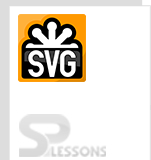 Introduction
Introduction
This chapter demonstrates about the SVG Tutorials like what is SVG and how to create and use SVG. In order to use the SVG user should be familiar with the Adobe illustrator, HTML, CSS and JavaScript. Following are the concepts are covered in this chapter.
- What is SVG
- History Of SVG
- Advantages & Disadvantages
 Description
Description
SVG Stands for Scalable Vector Graphic which is a two dimensional vector based graphic format and the name implies that is a scalable, i.e user can resize the dimension with out any loss of quality. Scalability allows user to use single graphics, which is rendered crisp and clean regardless of the pixel density or resolution.
SVG is recommended by W3C and which is also integrated with the other standards like DOM and XSL. SVG is an open source technology.
 Description
Description
The first public draft of SVG introduced in 1999 but which did not become a working draft, few months later SVG got candidate recommendation by W3C in August 2000.
The current version of SVG is 1.1 which was published as a W3C recommendation in August 2011. Earlier SVG was not supported by all the browsers but now supported by all the modern browsers. The wide Adoption of responsive web design with improved tools increased the use of SVG in web development projects.
 Description
Description
Following are some of the Advantages and Disadvantages Of SVG.
Advantages
Disadvantages
- SVG images can be created by different text editors.
- SVG images are scalable and which are searched, indexed, compressed and scripted.
- User can be print high quality SVG images at any resolution.
- SVG is an open standard and files are the pure XML files.
- SVG images have big size even for small image also.
- Text format size also larger when compared to the binary formatted raster images.
 Key Points
Key Points
- SVG is developed by World Wide Consortium.
- SVG images are defined in XML text files.
- SVG supported by all the modern browsers.



